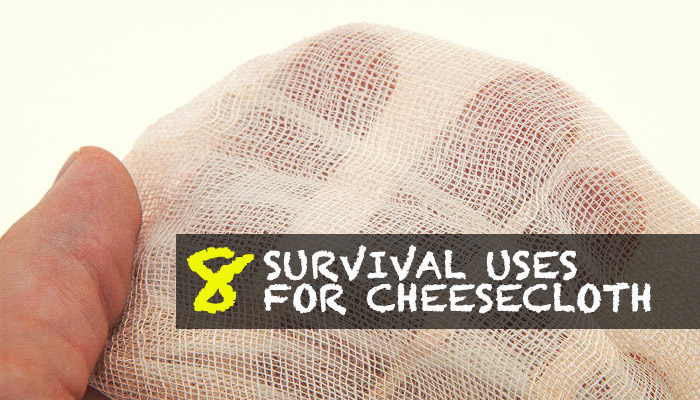
Cheesecloth is available in a number of grades ranging from loose to extra-fine weave. Grades are distinguished by the number of threads per inch in each direction.
The grades range from #10 to #90 with 10 being the loose grade and 90 being a tight weave. The # 10 grade, for example, has 20 vertical and 12 horizontal threads per inch, while, #90 has 44 vertical and 36 horizontal threads per inch. The other grades fall somewhere in between.
The uses are only limited by your imagination. However, this article will concentrate on survival/emergency uses.
1.) Water Filtration
When purchasing cheesecloth specifically for water filtration you would want the finest weave available to filter out the micro particles. However, any grade will work with varying results. To be effective you would want to use a filtering device with multiple filtering mediums.
The cloth would be placed in a container with a hole (s) in the bottom, and if it is the finest medium you have, it would go in first. Place the finest materials in first and the coarsest in last. The coarse filtering mediums will filter out the larger debris, and as the water permeates through the finer materials, they will filter out the micro particles.
2.) Medical
Because of its “gauze” like nature, it is only natural that it can be used as an emergency bandage or to wrap wounds or injuries. The cloth will soak up antibacterial cream so it can be applied loosely to wounds that cannot be wrapped tight such as burns to help reduce bacteria and to keep debris and insects away from the wound.
Use the cloth to make a sling for your arm, or to tie off splints to immobilize broken or injured limbs.
3.) Insect Netting
You would want the weave to be loose enough so you could see through it when using the cloth to make an insect net for your head and face. Drape the netting over your headgear so the material is not touching your skin to keep mosquitoes and flies from biting you through the cloth. Drape a heavier weave over your sleeping area or in doorways/windows.
4.) Fish/Bait Net
Bend supple saplings into a tennis racket shape and secure the cheesecloth to it, leaving enough slack in the material to scoop up bait or fish, or create a larger net for casting. To cast you would need to attach bobbers, weights and have cordage attached to drag the net.
5.) Emergency Dust/Contaminate Mask
You want the weave loose enough to breathe through and yet fine enough to filter out dust and blowing debris, or help prevent cold air from entering your mouth or nose. You may have to try several weaves to find the one that suits you best. Those with breathing problems will have to be especially careful because a fine weave may create serious problems for you.
6.) Food Uses
Air and/or sun drying of foods, in particular, meat has been in practice for thousands of years. However, you need to keep debris and insects from contaminating the foods, so wrap, or loosely drape the material over the food to prevent this from happening.
You can even wrap freshly butchered meat from a kill to transport back to camp. The cloth allows airflow to help keep the meat cooler in warmer weather and yet will keep insects and dust off the meat, and makes carrying the meat easier.
Use as makeshift coffee filters for your favorite brew, and some would consider not being able to make coffee an emergency, so we have to mention it here. Place ground coffee on a small section of cheesecloth and form into a sack and tie off and let simmer in hot water. Do the same with tealeaves.
7.) Camo Netting
Make irregular patterns on the cloth using camo sticks, charcoal, and/or mud to make Camo netting. Use the netting to wrap your firearms or longbows or drape over objects and your body.
The netting could be used to make an ad hoc ghillie suit by coloring with colors that match the environment as well as attaching local vegetation and mud to the cloth. As with any camouflage, it must blend into the environment you are operating in, so keep this in mind when packing your survival kit. Carry camo sticks, or small craft sized bottles of various earth-tone paints and use what you find in your environment.
8.) Abrasive Material
Make a small pouch and fill with sand to make a polishing ball to clean blades, smooth the finish on arrows or bows made in the field, or use to scrub eating utensils. There are other uses for abrasive materials, and you will discover more uses as you go along.
The weave has to be fine enough to contain the sand and yet loose enough allow the sand to make contact with the surface you are scrubbing or sanding. Adding some moisture to the surface you are cleaning may help the process.
Use the cloth by itself to polish or clean items and with a little chocolate, you can even polish the bottom of a soda to make a very reflective surface to create fire by magnification of the sun’s rays (very difficult by the way), or use the can as a signaling device. The cloth is ideal for cleaning eyeglasses, and binocular lenses.